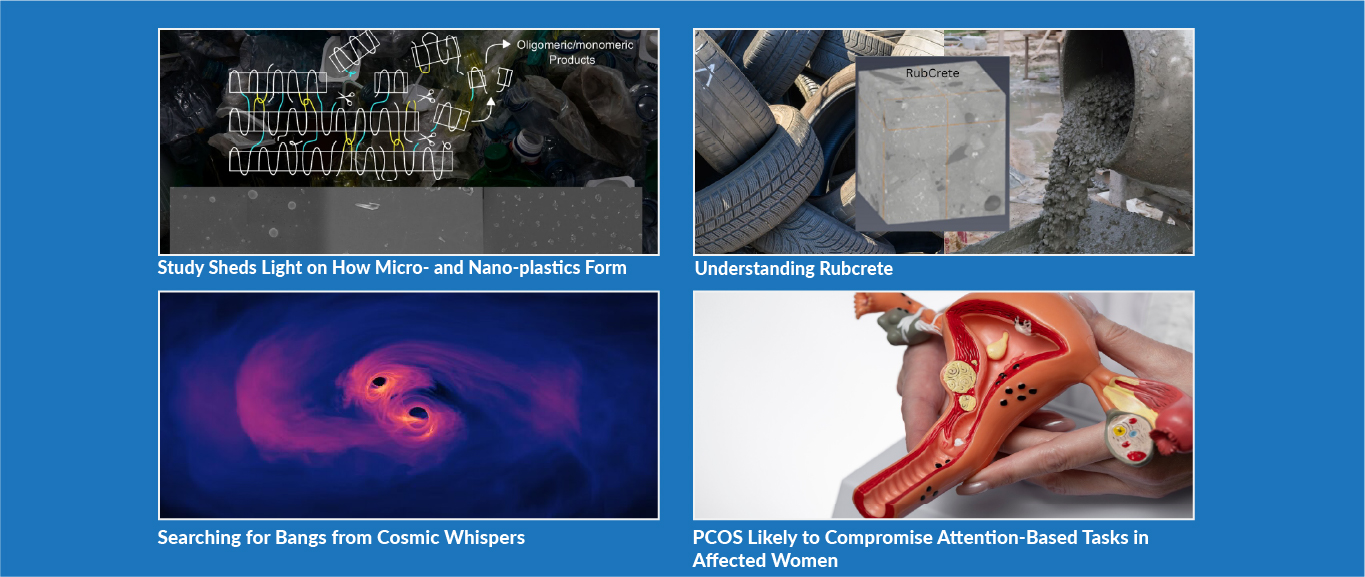1. Study Sheds Light on How Micro- and Nano-plastics Form
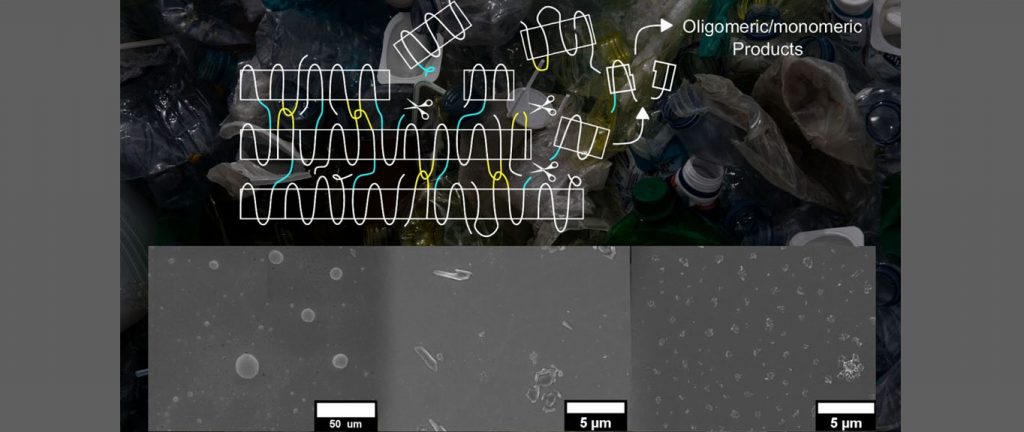
An illustration of how MNPLs form from the breaking of bridges between crystal sheets
Credits: Authors of the study
The following article was originally written by Mr. Arul Ganesh S S and published here.
A study by a team at IIT Bombay and their collaborators reveals how the majority of commercial use plastic degrades into micro and nano plastic particles
Micro and nanoplastics (MNPLs)—plastic fragments smaller than the thickness of a strand of hair—are fast becoming a serious ecological threat. They have been detected almost everywhere, from deep-sea sediments to human organs. Though there is increasing evidence regarding the medical and environmental harm they pose, it’s nearly impossible to avoid using plastics in daily life and commercial applications and, thereby, leakage of MNPLs into the environment. This makes it imperative to manage plastic waste better and prevent the formation and release of these tiny fragments into the environment. Understanding how MNPLs form is a crucial step in that direction.
A recent study in the Nature Communications journal by Prof. Kumaraswamy Guruswamy and Vivek Sharma from Indian Institute of Technology (IIT) Bombay, in collaboration with scientists from the Columbia University, USA, University of Vermont, USA, University of the Basque Country UPV/EHU, Spain, Basque Foundation for Science, Spain, and University of Tennessee Knoxville, USA, sheds new light on how MNPLs form through everyday environmental degradation of plastic waste. The study highlights the importance of scientifically informed plastic waste management practices. It suggests some changes to the structure of plastic materials, which may help reduce the formation rate of MNPLs.
Most commercially available plastics have what scientists call a semi-crystalline structure. They are made of crystalline (where the atoms are arranged in a periodic pattern, like in a salt crystal) sheets of plastic molecules (called lamellae) stacked one over another with threads of plastic running between and across these sheets. These threads often act as bridges holding the sheets together. The IIT Bombay team and their collaborators studied three of the most widely used plastics, namely polypropylene (PP), polyethylene terephthalate (PET), and polystyrene (PS), and simulated degradation under controlled lab conditions that mimic wear and tear caused by real-world environments like landfills. By accelerating the degradation process, they could observe in days what would naturally take years.
Across all three plastics studied, researchers observed that the threads degrade first. Once these break down, the stacked lamellae become unstable and fragment. While the fragments from ‘threads’ degrade quickly, the tiny lamellar fragments—the micro and nano plastics—persist for very long periods, potentially posing ecological and medical threats.
As Prof. Guruswamy says, “Once NPLs form and are dispersed in the environment, it is virtually impossible to intervene. It is not realistic to collect and filter out NPLs to clean up the environment.” One potential mitigation strategy suggested by the study is to increase the number of thread-like molecular bridges to strengthen the plastics. While this can slow down the formation rate of MNPLs, it cannot entirely prevent them from forming. The usefulness of semi-crystalline plastics also means that we cannot stop using them. Thus, better waste management strategies are essential to prevent particulate pollution. As Prof. Guruswamy explains, “While we think of plastics as persistent and indestructible, they are not. For example, a plastic chair left out in the sun will become brittle and degrade, releasing MNPLs. It would be best to collect and scientifically recycle or dispose of such objects before they degrade under poorly controlled conditions.”
Another key observation from the study is that there is a wide variability in the size and shape of MNPLs formed through the degradation of plastics. This challenges the common practice in toxicity studies of MNPLs that use nanoplastic particles of similar size and shapes as stand-ins for real-world nanoplastics formed through plastic waste degradation. As Prof. Guruswamy explains, “[The mimics used in laboratory studies on effects of MNPLs] differ significantly from nanoplastics produced by wear and degradation in terms of surface chemistry and size/shape variability. These differences could be critical for understanding toxicity and environmental impact.”
The depth and scope of the study were greatly enhanced by international collaboration. It was conceived by Prof. Guruswamy and his long-time collaborator, Prof. Sanat Kumar, from Columbia University. Prof. Sanat Kumar is also the Rajesh and Nisha Chair Visiting Professor at IIT Bombay. In the study, the IIT Bombay group handled polypropylene and polystyrene, while the Columbia team focused on PET. Currently, Prof. Guruswamy and his collaborators are investigating the implications of their results for recycling plastics. “During reprocessing, polymers can undergo molecular degradation, possibly making them more vulnerable to NPL formation”, Prof. Guruswamy explains the reason for looking at this particular problem.
While the MNPL samples from the real world are not being studied currently, that is a major area for future research, according to Prof. Guruswamy. However, directly collecting these particles from oceans or landfills remains a challenge. More international collaborations and extensive works will hopefully help us effectively tackle the challenges posed by these tiny plastic fragments, invisible to even normal microscopes, in the near future.
**********************************************************
The original academic article titled Mechanism of Quiescent Nanoplastic Formation from Semicrystalline Polymers was written by IIT Bombay’s researchers and published in the journal Nature Communications.
The original paper can be found here.
2. Understanding Rubcrete: How Waste Tyres are Making Concrete Tougher and Greener
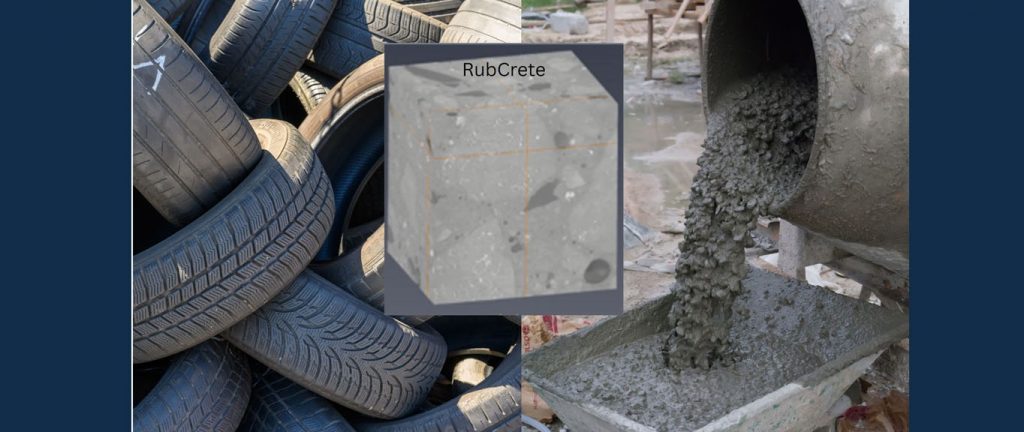
Inset: RubCrete made of shredded tyres and concrete.
Image Credit: Prithvendra Singh
The following article was originally written by Mr. Dennis Joy and published here.
A microscopic look reveals how the unique ‘handshake’ between rubber and cement could be key to durable, sustainable construction.
India is the world’s third-largest automobile market and, as a result, produces 2.5 million metric tonnes (MT) of tyres annually. The growth also implies an increasing amount of waste tyres, which make up 1% of our solid municipal waste, with 2 million MT of tyres discarded as scrap annually. An additional 0.8 million MT of scrap tyres is imported into India annually from countries such as the United Kingdom, Australia and UAE, where recycling tyres is prohibited. India is the largest tyre recycler in the world, home to 800 registered tyre recyclers and accounting for up to 70% of all tyre recyclers worldwide. However, despite the government setting strict recycling rules, many recyclers continue to illegally burn the tyres or discard them in landfills. These mountains of discarded tyres are a persistent environmental hazard, piling up in landfills or releasing toxic fumes when burned.
One way to address the piling rubber waste is to reuse the rubber as a reinforcement agent in concrete. Researchers around the globe have been exploring ways to replace some of the natural aggregates in concrete, like sand and gravel, with shredded waste rubber (25-30 mm in size), dubbed WasRub, creating a material known as RubCrete. The method finds a use for problematic waste while reducing the need to quarry natural stone and sand, which are generally otherwise used in concrete. However, getting the right mix involves understanding precisely how the ingredients interact, especially at the microscopic level. This is exactly what researchers from the Indian Institute of Technology (IIT) Bombay have done in their recent study, under the guidance of Prof D. N. Singh from the Department of Civil Engineering.
Conventional concrete combines cement (the binder) and aggregates, like sand and gravel. The strength of the concrete heavily depends on the bond between the cement paste and these aggregates. This crucial microscopic connection zone is called the Interfacial Transition Zone, or ITZ. It’s a microscopic region, thinner than the width of a human hair, where the properties are slightly different from the main bulk of the cement or the aggregate itself. In Rubcrete, some natural stone and sand are swapped with rubber pieces, which behave very differently from stone. Because of the rubber pieces, Rubcrete is flexible, less dense, and crucially hydrophobic or repels water.
Researchers from IIT Bombay embarked on a detailed investigation to understand the ITZ in RubCrete, zooming in on the microscopic handshake between rubber particles and the surrounding cement. They suspected that rubber’s water-repelling nature and mere physical presence would significantly alter this zone compared to traditional concrete. The hydrophobic nature of the rubber means that the cement paste never touches the rubber particles, essentially forming a ‘wall’ around the rubber. “The wall effect disrupts the even distribution of cement grains near rubber particles, creating a porous zone around them,” explains Prithvendra Singh, a PhD scholar at IIT Bombay and the lead author of the new study.
The rubber also pushes away the water on its surface, which the cement needs to hydrate, react, and harden. This accumulation of water on the rubber’s surface ‘dilutes’ the reaction and is thus called the ‘dilution effect’. The IIT Bombay team hypothesised that the Wall and Dilution Effect (WDE) together predict a more porous and potentially weaker ITZ around the rubber particles, causing RubCrete to be softer than its natural concrete counterpart. This is where the challenge and the opportunity lie for RubCrete.
The researchers employed a suite of tools to probe the RubCrete samples to test this effect. They extracted powder samples from three specific regions in the RubCrete sample: right next to the rubber bits, near the natural aggregates, and from the main cement paste body. They identified the specific minerals and chemical bonds formed during the cement hydration process using imaging techniques like X-ray Diffraction (XRD) and Fourier Transform Infrared Spectroscopy (FTIR). They found the expected concrete hydration products like calcium silicate hydrate (C-S-H), the primary glue in concrete, and calcium hydroxide (C-H). However, the distribution and presence of other minerals like Anorthite differed in samples obtained near the rubber.
The researchers used Thermogravimetric Analysis (TGA), which measures an object’s weight change with changing temperatures, to reveal how much water was trapped within the structure. They then turned to Scanning Electron Microscopy (SEM) coupled with Energy Dispersive Spectroscopy (EDS) for a visual and compositional map of the ITZ, allowing them to see the microstructure, including the tiny pores, the unreacted cement grains, and the hydration products.
The team also recorded the hardness and stiffness of the Rubcrete using a process called Nanoindentation. This involved indenting the material’s surface at various points across the ITZ with a diamond-tipped needle and recording its force and displacement. Next, they used X-ray micro-Computed Tomography (micro-CT), creating a high-resolution 3D X-ray image of the concrete’s internal structure. Using the technique, they could measure the ITZ thickness and found that it ranged from 35 to 120 micrometres, wider than usually seen in conventional concrete. The method also allowed for the quantification of porosity within this zone for a selected region of interest, finding it to be around 5.8%. Critically, the 3D view suggested these pores were somewhat disconnected.
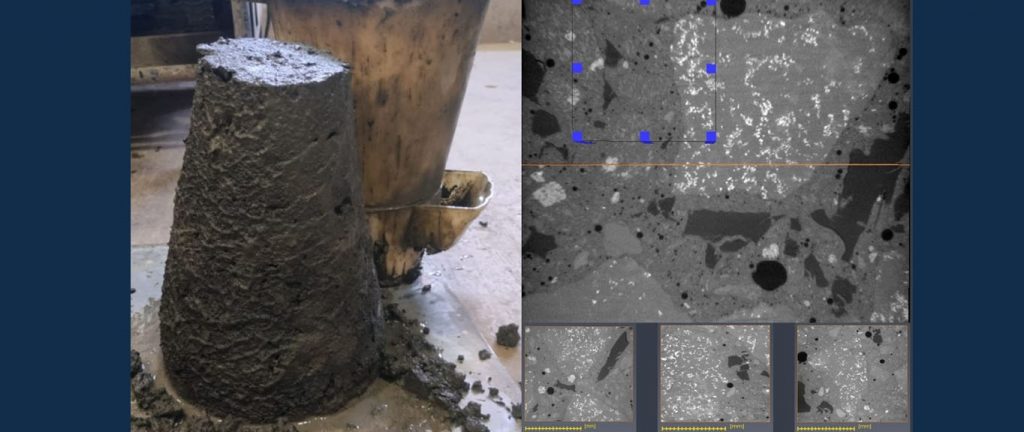
Left: RubCrete being moulded. Right: Scanned images showing the structure of Rubcrete.
Image Credit: Prithvendra Singh
Their tests confirmed that the WDE creates a distinct ITZ in RubCrete. This zone is wider, more porous, and mechanically weaker at the micro-level compared to the bond with natural aggregates. This explains why RubCrete generally has lower compressive strength than conventional concrete.
However, this perceived weakness holds a surprising advantage. The increased porosity, especially the network of somewhat disconnected pores, acts like a more complex, tortuous pathway for aggressively corrosive substances like salt water. “The most surprising finding is that while rubber weakens the immediate bond with cement, it forms a disconnected pore network in the ITZ, which slows down mass flux (mass movement) of chlorides, moisture etc. This trade-off benefits applications where chemical resistance outweighs strength, such as in extreme climatic and marine environments,” remarks Prithvendra.
Furthermore, the inherent flexibility of the rubber particles and the slightly weaker ITZ contribute to RubCrete’s known benefits: it’s less brittle, can absorb more energy from impacts, and has better resistance to fatigue cracking. According to Prithvendra, “RubCrete’s strength lies in its damping and flexibility, as well as its resistance to environmental stresses (thermal and chemical). The most immediately beneficial applications would be road barriers and pavements exposed to temperature swings, coastal and marine structures where chloride ingress is a concern, and shock-absorbing systems like railway buffers or earthquake-prone infrastructure.”
This study advances our understanding of RubCrete and its unique properties by integrating multiple sophisticated techniques to paint a detailed, multi-scale picture. Although previous work on RubCrete identified its lower strength and higher ductility, the new research provides a more precise, microscopic explanation of the properties. It also identifies a surprising benefit arising from the disconnected pores formed due to the rubber.
The team behind the study are now looking to test RubCrete in real-world applications.“So far, we have focused more on microstructural behaviour than on direct exposure to environmental cycles. Real-world, long-term testing needs to be performed by placing RubCrete in marine zones, salt spray chambers, and freeze-thaw environments for long durations,” remarks Prithvendra, talking about the limitations and future directions of the research.
The study reinforces that RubCrete is not just a way to recycle old tyres. It’s a potential pathway to creating smarter, more sustainable construction materials uniquely suited for the challenges of extreme conditions, helping us build greener and tougher structures in the face of environmental adversity.
**********************************************************
The original academic article titled Interfacial Transition Zone in Rubberized Concrete: A Panacea for the Extreme Environmental Conditions was written by IIT Bombay’s researchers and published in the journal Construction and Building Materials, Volume 469.
The original paper can be found here.
3. Searching for Bangs from Cosmic Whispers
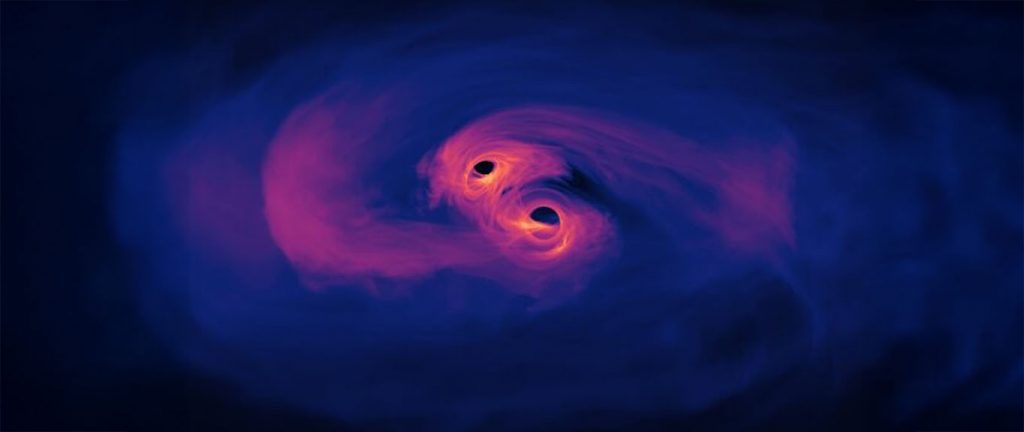
Simulated electromagnetic (EM) emission from accreting binary massive black hole during the late inspiral phase.
[NASA/GSFC]; Credits: https://svs.gsfc.nasa.gov/13086/
The following article was originally written by Ms. Kshitija Kelkar and published here.
Researchers look for high-energy light from gravitational-wave candidates in LIGO-Virgo-KAGRA Observation Runs with India’s AstroSat-CZTI
We can “see” our universe because our eyes can detect light in the form of energy quanta or packets of energy called photons or electromagnetic (EM) waves. However, besides electromagnetic (EM) waves, our universe also uses other messengers to carry information such as the recently discovered gravitational waves (GW). These waves are produced when pairs of massive objects, such as extremely magnetic neutron stars and black holes, rapidly accelerate towards each other and eventually merge into a single entity. Today, the global GW Network, which includes the American LIGO, the European Virgo Gravitational Wave interferometer (Virgo), and the Japanese Kamioka Gravitational Wave detector (KAGRA), is geared towards capturing the GW signals from such extreme gravitational interactions.
Prof Varun Bhalerao and his research team from the Department of Physics at the Indian Institute of Technology Bombay are investigating the detection of an electromagnetic (EM) signal in conjunction with the gravitational waves (GW) produced by merging pairs of neutron stars, black holes, or a neutron star-black hole pair. Their research seeks to address a significant question: can a merger of two black holes generate a ‘light’ signal (EM signal), or is it essential for one of the objects in the pair to be a neutron star?
Determining the answer to this question will greatly enhance our capacity to monitor these gravitational wave events through existing observational facilities as detecting electromagnetic waves is easier as compared to detecting gravitational waves. The answer will also help model the characteristics of gravitational wave sources, and eventually grasp the emission mechanisms of high-energy light resulting from these merging incidents. Notably, among the 90 detections to date the global GW network witnessed an EM signal associated with a GW only once in 2017, specifically for a binary neutron star merger, which varied from gamma-ray bursts to optical light observed days after the merging event. So far we have not detected EM signals from merging of two black holes or a neutron star-black hole pair.
Gaurav Waratkar, who was involved in this work, explains, “If binary black hole mergers emit X-rays, it would challenge our current understanding of the fundamental physics governing these extreme, highly energetic collisions, shedding new light on their dynamics and energy release mechanisms. These exotic events are thought to produce X-ray bursts, and detecting them would provide critical insights into their physical processes”.
The Cadmium Zinc Telluride Imager (CZTI) on India’s AstroSat space observatory is ideal for detecting such high-energy interactions. It is one of the four X-ray instruments onboard AstroSat and can detect X-rays across a broad energy spectrum ranging from 20 – 200 keV. Gaurav and team used AstroSat-CZTI to search for high energy X-ray emissions coinciding with GW events recorded by LIGO-Virgo-KAGRA within 100 seconds following the GW emission trigger. “AstroSat-CZTI is crucial for this search, having proven to be a highly capable detector with numerous burst discoveries since its launch,” remarks Gaurav.
The research team utilised data from the three initial observing runs of the GW detector to conduct a comprehensive all-sky search. The searches encompassed a luminosity distance of up to 457 million light-years for binary neutron stars and 32 billion light-years for binary black hole mergers. With AstroSat observing around ~70 of these GW detections, they methodically examined each neutron star-black hole pair and binary black hole pairs.
Due to the complexities of space observations, the search faced many challenges. These could include instances where our Earth gets in the way of the probable target and AstroSat. Additionally, certain events might fall outside of Astrosat-CZTI’s sensitivity range or simply be too distant to capture the EM radiation.
AstroSat-CZTI did not detect any of these events in X-rays. This information is extremely useful since it allows us to constrain the characteristics of such events. With such a large sample, this study has been able to confidently state that the maximum brightness these events could have had is lower than the lowest brightness that AstroSat can detect. The limits from AstroSat are as
good as those from any other X-ray telescope in the world. These limits are essential to decide on the EM radiation models complementing the GW emission from these binary black hole mergers.
Elaborating on the future scope of this work, Prof. Varun Bhalerao explains, “The universe is the most extreme laboratory of physics and has always surprised us with new, unexplained phenomena. Looking for X-ray bursts from black hole mergers helps us validate humanity’s understanding of physics and look for newer, deeper theories. When LIGO India becomes operational, we will find more distant black hole mergers. For studying those, the proposed Indian Daksha mission would prove to be revolutionary.”
The GW detectors are expected to end their fourth observing run in October 2025. This will further extend the luminosity search distance to at least 554 million light years for binary neutron star mergers and give us a wider sample of GW sources from our surrounding universe. India’s future space mission, Daksha, is being built specifically to detect and understand EM radiation from such GW sources, thanks to the planned extremely sensitive Cadmium Zinc Telluride (CZT) detectors and all-sky coverage.
**********************************************************
The original academic article titled Bright in the Black: Searching for Electromagnetic Counterparts to Gravitational-wave Candidates in LIGO-Virgo-KAGRA Observation Runs with AstroSat-CZTI was written by IIT Bombay’s researchers and published in The Astrophysical Journal.
The original paper can be found here.
4. PCOS Likely to Compromise Attention-Based Tasks in Affected Women

Image Credit: Freepix
The following article was originally written by Ms. Divyapriya Chandrasekaran and published here.
Hints A Study Task-based tests reveal that PCOS impacts women’s focused and divided attention, decreasing speed of response by about 56% and accuracy by about 10%
Polycystic Ovary Syndrome or PCOS is a well-known endocrine disorder in women, with symptoms like irregular or absent periods, polycystic ovaries, and increased levels of male hormone (androgen). While we know that women suffer from these physical conditions, we know less about their mental effects. An earlier research underlines that Indian women with PCOS show an increased level of anxiety and depression. For example, they avoid social events due to the fear of being judged for their weight gain or feel hopeless due to constantly battling irregular periods.
The effect of PCOS on attention is less explored. Attention is the precursor for all vital cognitive processing—receiving, understanding, and making sense of the information. Attention is also a complex process that involves focusing on relevant information and filtering out irrelevant stimuli (focused attention). Divided attention helps us handle and respond to multiple tasks simultaneously.
In their recent study, Maitreyi Redkar and Prof Azizuddin Khan from the Psychophysiology Laboratory, Department of Humanities and Social Sciences at the Indian Institute of Technology Bombay (IIT Bombay) assessed the impact of PCOS on focused and divided attention. Two groups of participants, 101 women with PCOS and 72 healthy women, underwent the attention tasks. Their hormonal levels were assessed before the study. The task-based tests showed that women with PCOS are slower to react and more easily distracted than their healthy counterparts.
“The cognitive experiments are specifically designed to capture the subtle millisecond-level differences in how individuals respond to critical stimuli. These minute delays reveal significant impairments in attention, which may impact our real-life functioning. In the specific context of focused attention, it is not just about concentrating on the task at hand to respond at the right time, but also inhibiting irrelevant distractors,” remarks Prof. Khan, who led the study.
Researchers used two task-based tests, the Flanker Task and the Posner Cueing Task, to test PCOS and healthy individuals for accuracy and response time (speed). The Flanker Task assesses the participant’s ability to avoid distracting stimuli while focusing only on the important information. “In this task, the participants are instructed to focus on a target stimulus (usually an arrow or a letter) that appears in the middle of a row while ignoring the distracting stimuli on either side (the “flankers”). For example, if the participant is shown “→→→→→”, the middle arrow is easy to identify. However, if they are shown”←←→←←”, the surrounding arrows point the other way, making it harder to concentrate and respond accurately,” adds Prof. Khan.
The Posner Cueing task evaluates how quickly the participants focus on the correct spot and how efficiently they shift their focus from the wrong one. The test assesses their divided attention. Participants were asked to focus on the centre of the screen (central fixation point) with two boxes on either side. They receive a cue, such as an arrow or a flash, followed by a target stimulus in one of the boxes. The participants should quickly press the corresponding arrow key. Their reaction times would be quicker if the cue and target appeared on the same box. This task evaluates the speed and accuracy of the participants by studying how quickly they shift their focus between the cue and the target.
Women with PCOS showed over a 50% slower response and made about 10% more errors than the healthy ones in the focused attention test. Similarly, PCOS women performed about 20% slowly, with 3% extra errors in the divided attention task. Among the two types of attention, PCOS women performed poorer in focused attention. The hormonal imbalance associated with PCOS could lead to decreased alertness and longer reaction times. Along with elevated androgen levels, the participants with PCOS had insulin resistance that is linked to attention. Insulin resistance causes poor glucose metabolism and affects brain cell (neuron) activity, leading to poor performance in focused attention tasks.
Mental fatigue linked to PCOS, such as anxiety and frustration, makes divided attention tasks more challenging. The finding of the study highlights that decreased accuracy in divided attention tasks may influence working memory, which hinders holding the information temporarily. This makes daily activities such as keeping track of directions while driving or remembering a phone number to dial more challenging.
“PCOS is a heterogeneous condition, which means that its symptoms and severity vary depending on the hormonal profile, metabolic health, mental health and socio-environmental conditions of the individual. Despite the variability in PCOS symptoms and their severity, the impairments in the core cognitive abilities of attention and processing speed seem to be prevalent across women,” adds Prof. Khan.
While the challenges of low accuracy and slow response time seem daunting, there is a light at the end of the tunnel. Playing brain games focusing on attention and memory can improve response time (speed) and accuracy. Relaxation and stress reduction techniques may reduce stress and anxiety and improve focus and speed.
“Increasing physical activity levels, maintaining a nutritious diet, and reducing weight are beneficial not just for PCOS symptoms but also for cognitive health. Even improving sleep hygiene contributes significantly to improving attentional accuracy and reaction time,” suggests Prof. Khan.’
The findings emphasise the need to understand PCOS as a complex medical condition that not only affects physical but also cognitive health. A comprehensive intervention that addresses diverse aspects, including supportive care, will help the well-being of women with PCOS.
**********************************************************
The original academic article titled The Impact of Polycystic Ovary Syndrome on Attention: An Empirical Investigation was written by IIT Bombay’s researchers and published in the journal BioPsychoSocial Medicine.
The original paper can be found here.

Annual Activity Report 2024-25
View Now View NowEngage with us
We welcome your ideas and suggestions and encourage you to get in touch with us at





